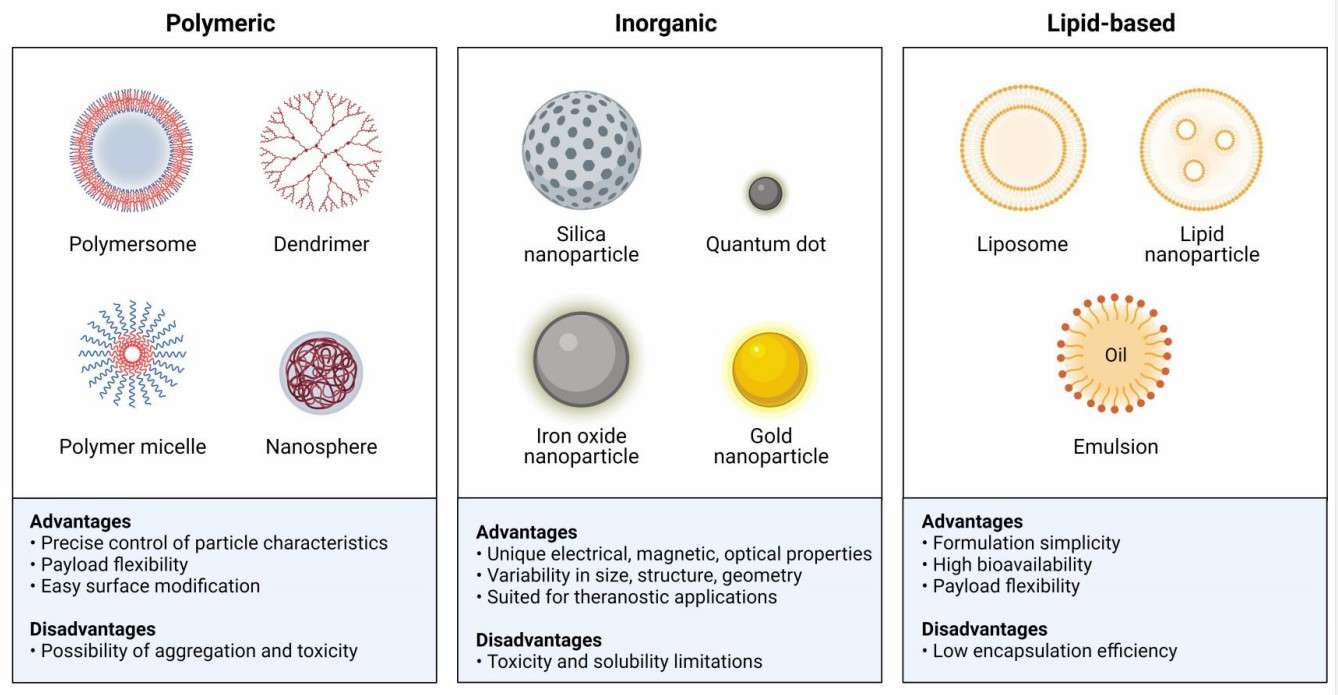In the field of modern medicine, nanotechnology has become a game changer, enabling the development of innovative therapeutic vehicles known as nanoparticles. The dimensions of these tiny structures are usually less than 100 nanometers, opening up a direction for precise targeting and efficient delivery of drugs. CD Bioparticles provides a variety of nanocarrier systems for drug delivery to facilitate the development of nanocarrier drugs.
As an emerging technology, nanoparticles refer literally to tiny particles. Existing research has found that such tiny particles within 100nm can deliver therapeutic agents to specific parts of the body. Key to their success is their size, which allows them to penetrate biological barriers, such as cell membranes, more efficiently than traditional drug delivery methods.
 Figure 1. Classes of nanoparticles.
Figure 1. Classes of nanoparticles.
With the development of nanotechnology, various forms of nanoparticles have been synthesized and studied, including liposomes, polymers, dendrimers, biodegradable polymer, exosomes, metal-organic frameworks, QDs, and metal nanoparticles, etc. Among them, each type of nanoparticles exhibits unique properties and application ranges due to differences in composition and structure. For example, liposomes have a phospholipid bilayer similar to that of cell membranes, which makes them highly biocompatible; polymers provide greater flexibility in drug loading and release due to their diverse composition.
Enhance drug delivery:
One of the major advantages of using nanoparticles for therapeutic delivery is the ability to enhance the pharmacokinetics of drugs. Traditional delivery methods, such as oral pills or intravenous injections, often result in a large portion of the drug being metabolized before it reaches its intended target. However, nanoparticles can protect the drug payload and ensure that it reaches the site of action with minimal loss.
Additionally, nanoparticles can be designed to release drugs in a controlled and sustained manner. This means that therapeutic agents are gradually released over time, maintaining therapeutic concentrations in the body and reducing side effects associated with sudden drug release.
Targeted therapy:
Nanoparticles also enable precision in drug delivery that was previously unattainable. By modifying the surface of nanoparticles with specific ligands or antibodies, researchers can create vectors that target diseased cells while sparing healthy cells.
This targeted therapy can minimize collateral damage to healthy tissues, reduce the severity of side effects, and improve treatment outcomes.
Cancer treatment:
Cancer treatment is one of the most promising areas of nanoparticle research. Although chemotherapy drugs are effective in killing cancer cells, they also often damage healthy tissues. Nanoparticles can be designed to specifically target cancer cells, minimizing damage to other parts of the body.
In addition to targeted drug delivery, nanoparticles can also carry imaging agents, allowing monitoring of treatment progress.
This means doctors can monitor the tumor's response to treatment in real time and make adjustments if necessary.
Nervous system disease:
Nanoparticles are also receiving increasing attention in the treatment of neurological diseases.
The blood-brain barrier is a protective barrier surrounding the brain that poses a significant challenge to drug delivery to the central nervous system.
Nanoparticles can bypass or alter this barrier, opening up new possibilities for treating diseases such as Alzheimer's disease, Parkinson's disease and brain tumors.
Infectious diseases:
Nanoparticles are being explored as a means of combating infectious diseases, including viral infections.
They can be engineered to target and neutralize viruses, offering potential for the development of antiviral therapies.
Additionally, nanoparticles can improve vaccine delivery and improve the body's immune response.
Nanoparticles used as therapeutic vehicles represent a revolutionary advance in medicine. The ability to improve drug delivery, target specific cells, and improve treatment outcomes holds promise for many pathological conditions. As research continues and challenges are overcome, nanoparticles will play an increasingly important role in the future of healthcare, offering hope for more effective, targeted treatments.
1. Download the template.
2. Enter product information on the template (maximum number of products: 200).
3. Load the file using selector below.
1. Download the template.
2. Enter product information on the template (maximum number of products: 200).
3. Load the file using selector below.